North America Coworking Spaces Market Size
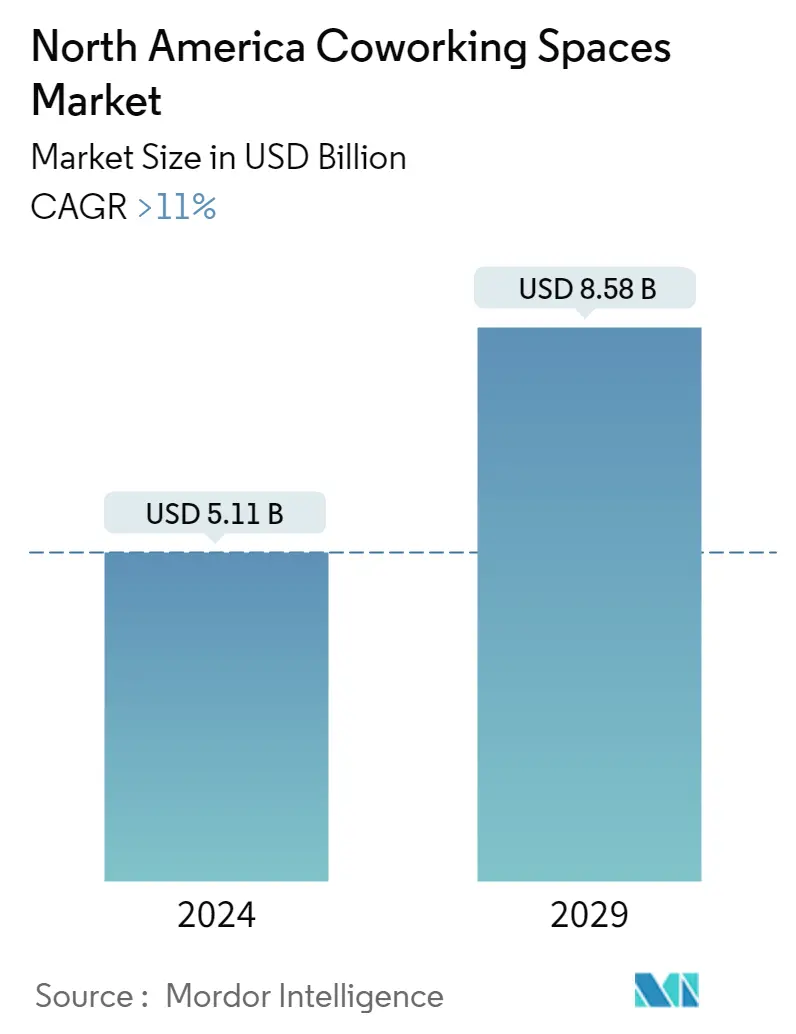
| Study Period | 2020 - 2029 |
| Base Year For Estimation | 2023 |
| Market Size (2024) | USD 5.11 Billion |
| Market Size (2029) | USD 8.58 Billion |
| CAGR (2024 - 2029) | 11.00 % |
| Market Concentration | Low |
Major Players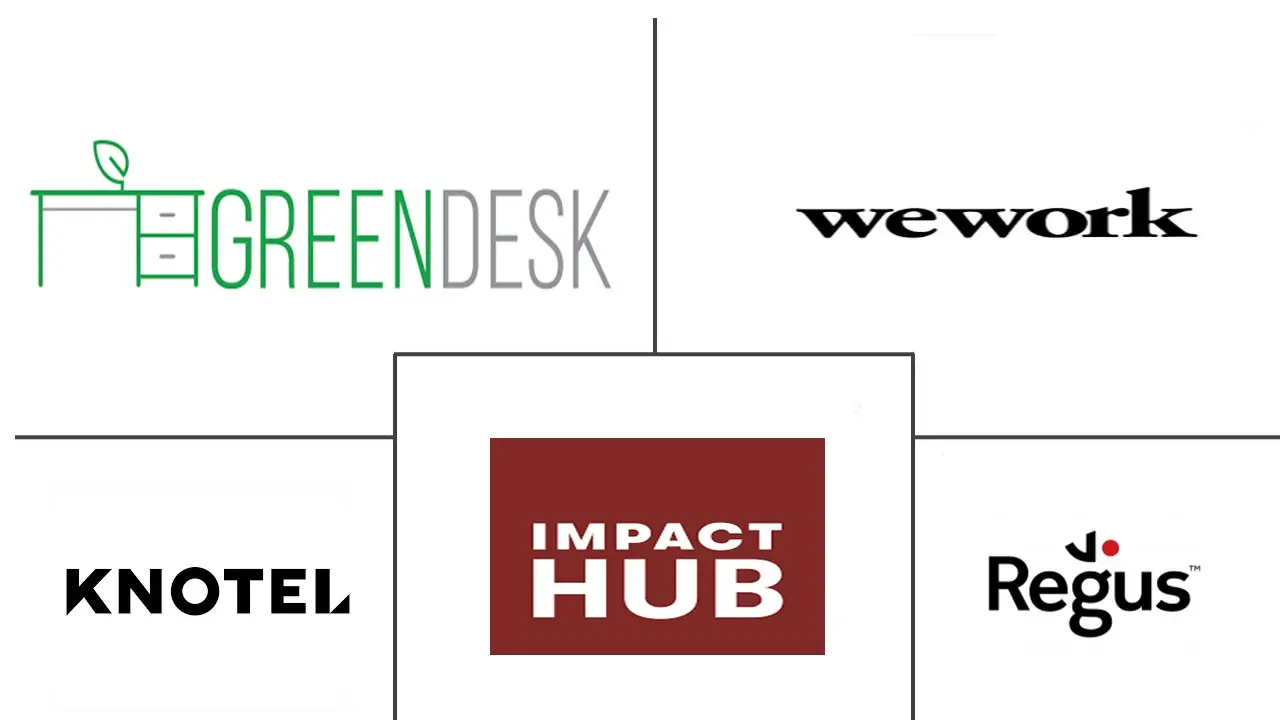
*Disclaimer: Major Players sorted in no particular order |
North America Coworking Spaces Market Analysis
The North America Coworking Spaces Market size is estimated at USD 5.11 billion in 2024, and is expected to reach USD 8.58 billion by 2029, growing at a CAGR of greater than 11% during the forecast period (2024-2029).
- The global expansion in the number of startups significantly impacts the coworking space industry. The United States is the leading country by the number of startups 75,056 in FY 2022-23. The extension of internet space, exposure to entrepreneurial expertise outside the country's borders, and better literacy rates all contribute to the rise.
- Furthermore, advanced manufacturing and robotics, agriculture technology and novel food, blockchain and artificial intelligence, big data, and analytics were the fastest-expanding startup sub-sectors worldwide. As a result, the growing number of startups in various sectors worldwide raised the demand for coworking spaces, boosting the market over the projection period.
- Sustainable coworking space development is a significant trend affecting the coworking space industry. Coworking spaces are introducing eco-friendly measures in the workplace to attract entrepreneurs worried about environmental challenges, such as global warming. Sustainable measures used by coworking space providers bring significant benefits and are economically possible.
- Furthermore, expanding investments in specialty coworking spaces such as women-only spaces, LGBTQ+ spaces, and other social spaces will likely generate profitable opportunities as they become more popular to meet the growing diversity in SMEs such as on-premise childcare.
North America Coworking Spaces Market Trends
Increasing number of Startups Boosting the Market
As the cost of private office space rises, many entrepreneurs opt for coworking spaces, fueling the expansion of the coworking space industry. Last year, investors poured USD 329.5 billion into startup investments at all stages over a year. This is a 92 percent increase above 2020, record-breaking levels. The year also concluded on a high note, with fourth-quarter investment totaling USD 88.9 billion in stages.
In North America, number of business applications was the highest on record in the previous year, a stunning 53 percent increase over the total filed applications in 2019 and a 23 percent increase over the total filed applications in 2020. In 2021, about 5.4 million applications to start new firms were lodged, the highest of any year since 2005. The exceptional filing rate translates into about 1.9 million more business applications in 2021 than in 2019 before the pandemic, a 53 percent increase.
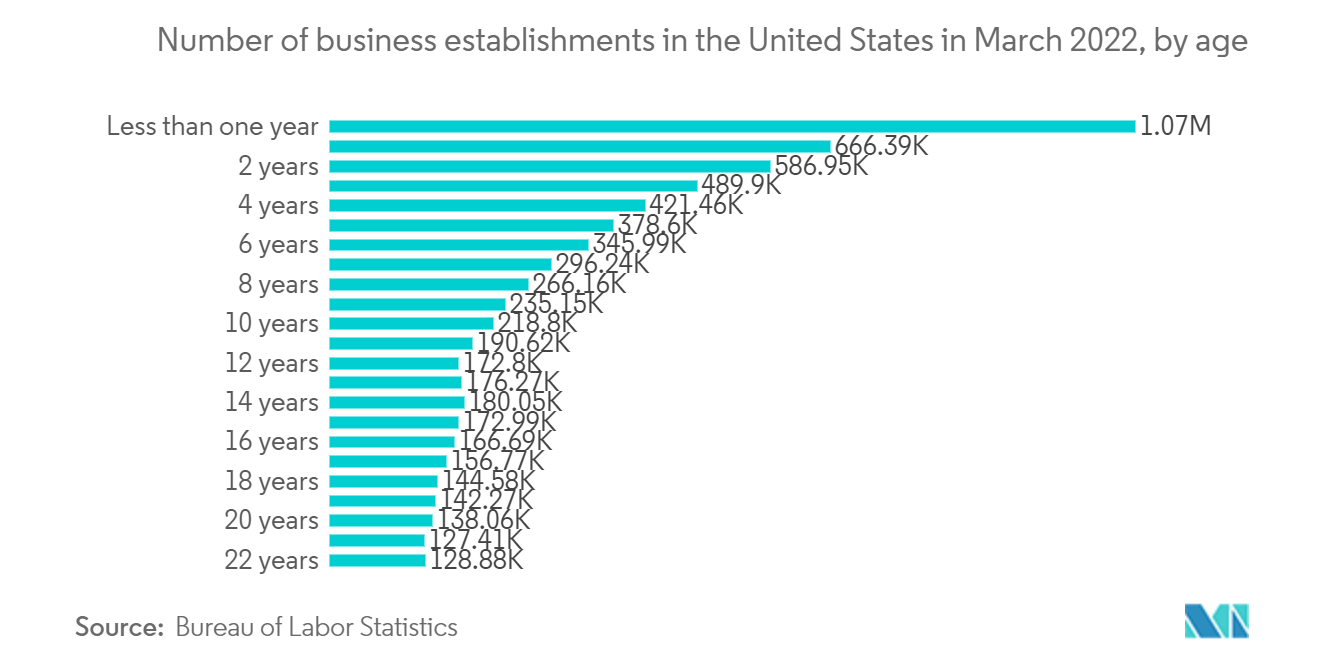
The US leads the Coworking Spaces Market in terms of Real Estate (Sq. feet)
In terms of size, North America has the most coworking spaces, with an average of 9,799 square feet per location. The increased acceptance of flexible work methods, service offices, and remote teams fuel this massive demand for coworking space, with coworking giants like WeWork and Regus managing 23 million square feet.
New York has the largest concentration of flexible working spaces, with over 330 coworking centers. The Instant Group, a global workplace innovation organization, forecasts a 19% growth in flexible office space demand in New York City in 2022 over 2021, while supply - the number of flexible workspace centers in the market - has increased by 7% to 495 spaces. This expansion is most visible in Manhattan and Brooklyn. New York City's flexible office space supply mostly comprises hybrid spaces, which represent 51% of the market. Following that, serviced offices account for 34%, while coworking spaces account for 15%.
This growth is being led not only by freelancers and start-ups looking for casual coworking environments but also by larger corporations utilizing this flexible space to expand their business in a controlled and affordable manner. New York isn't the only place in the US experiencing a growth spurt. Los Angeles, San Francisco, and Chicago have all witnessed more than 15% year-on-year growth in coworking spaces with currently over 566 workspaces.
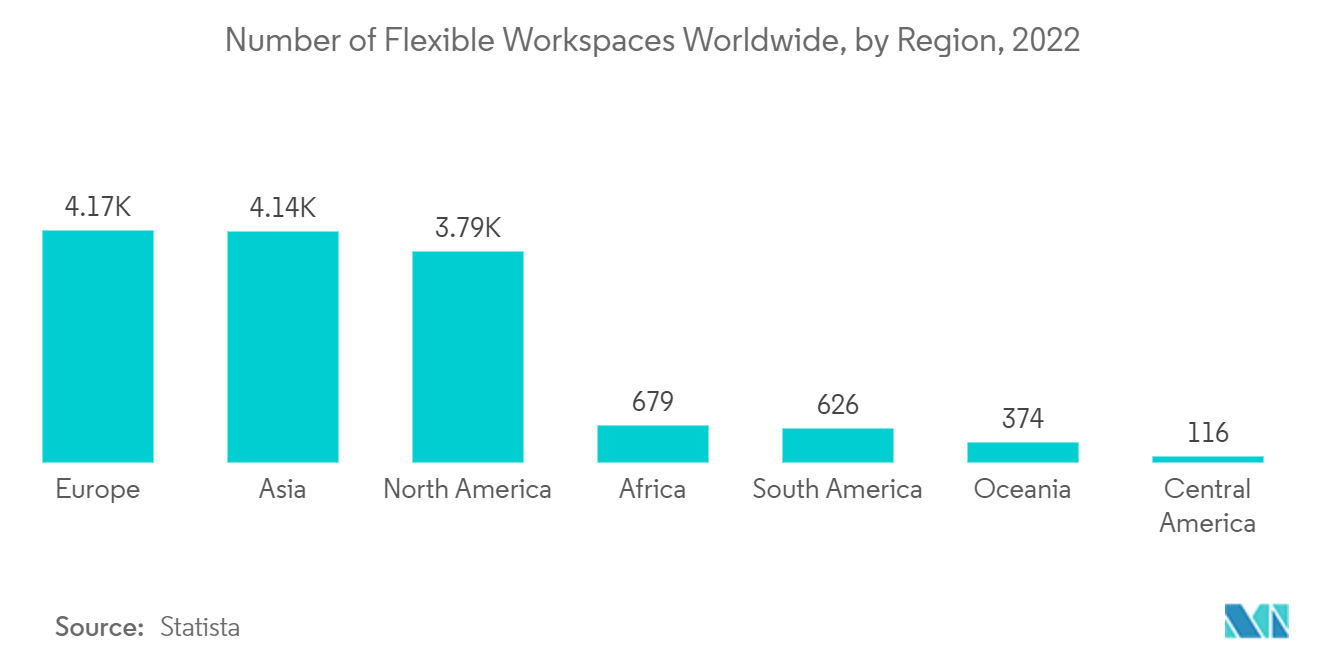
North America Coworking Spaces Industry Overview
The industry is quite fragmented, with many players existing in the coworking spaces market. Also many more are entering the market to fulfill the rapid demand for casual environment offices. As far as the competitive landscape is concerned, WeWork leads the market, with over 400,000 members across the globe, followed by Regus and Ucommune.
Some other major players in the market include Impact Hub, Alley, Knotel, IWG, Make Office, Industrious Office, Techspace, Serendipity Labs, and Green Desk.
North America Coworking Spaces Market Leaders
-
Impact Hub
-
WeWork
-
Green Desk
-
Knotel
-
Regus Coworking
*Disclaimer: Major Players sorted in no particular order
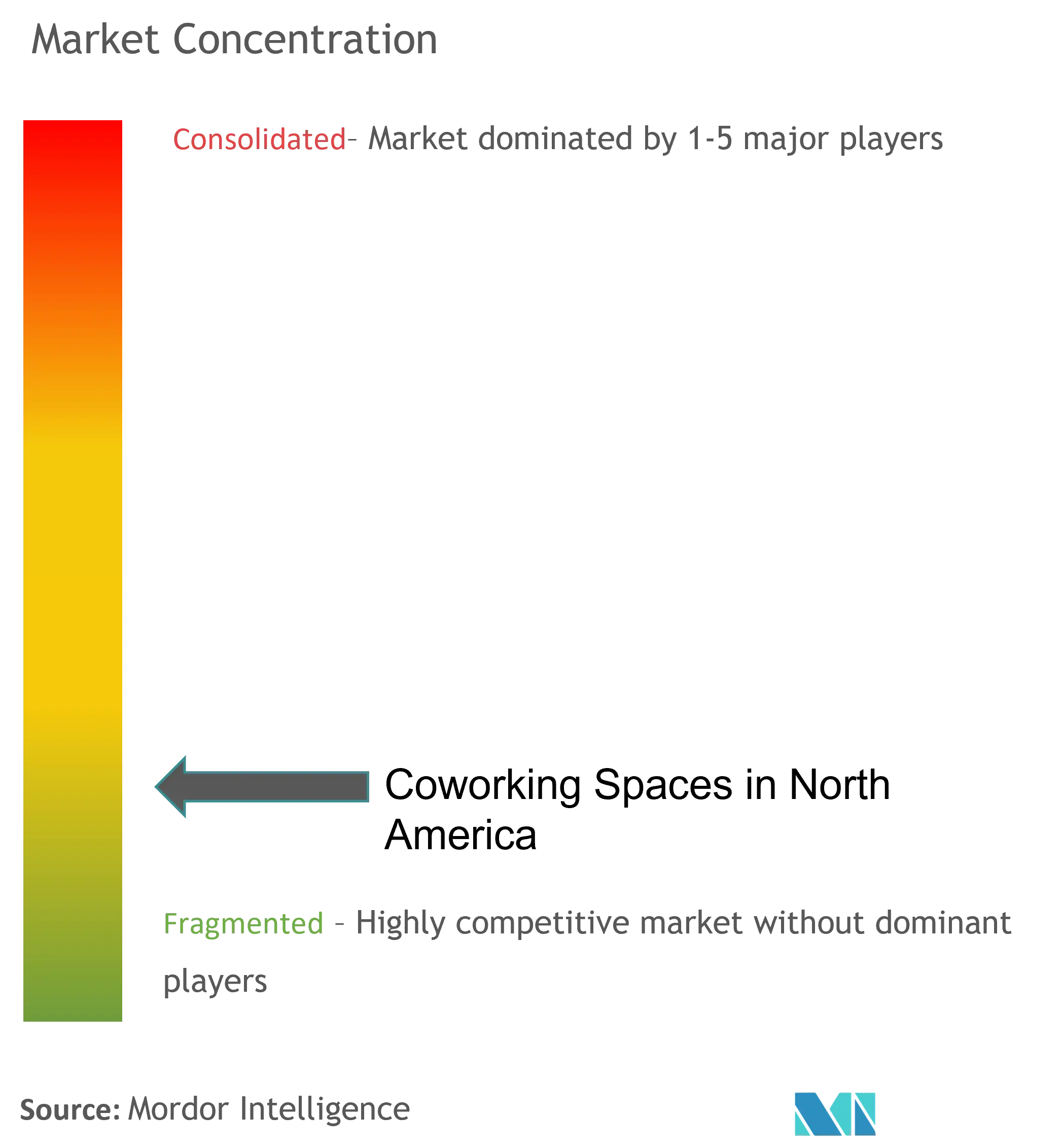
North America Coworking Spaces Market News
- November 2022: The Newmark-owned firm Knotel secured a long-term lease for 23,700 square feet at Ofizzina, a Coral Gables, Florida, office condo project. Knotel intends to finish three complete stories of the 16-story skyscraper at 1200 Ponce De Leon Boulevard. TSG Group and BF Group created Offizina, which comprises 60 office condominiums.
- June 2022: IWG, a Swiss coworking pioneer, intends to add up to 700 more flexible-office sites to its US portfolio, which now comprises offices in 300 cities, mainly under the Regus and Spaces brands. In the next 12 months, IWG plans to open 500 to 700 additional offices in the United States.
North America Coworking Spaces Market Report - Table of Contents
1. INTRODUCTION
- 1.1 Study Assumptions
- 1.2 Scope of the Study
2. RESEARCH METHODOLOGY
3. EXECUTIVE SUMMARY
4. MARKET DYNAMICS
- 4.1 Market Overview
-
4.2 Market Drivers
- 4.2.1 Growing demand for flexible office spaces
- 4.2.2 Surge in investments in niche co-working spaces such as women-only spaces, LGBTQ+ spaces, and other social groups
-
4.3 Market Restraints
- 4.3.1 Low Awareness and Privacy Issues
-
4.4 Market Oppurtunites
- 4.4.1 Increasing Investment for Improvement and Diversification of Coworking Space
-
4.5 Industry Attractiveness - Porter's Five Forces Analysis
- 4.5.1 Bargaining Power of Suppliers
- 4.5.2 Bargaining Power of Buyers/Consumers
- 4.5.3 Threat of New Entrants
- 4.5.4 Threat of Substitute Products
- 4.5.5 Intensity of Competitive Rivalry
- 4.6 Impact of Covid-19 on the market
5. MARKET SEGMENTATION
-
5.1 By Business Type
- 5.1.1 New Spaces
- 5.1.2 Expansions
- 5.1.3 Chains
-
5.2 By Business Model
- 5.2.1 Sub-lease Model
- 5.2.2 Revenue Sharing Model
- 5.2.3 Owner-Operator Model
-
5.3 By End User
- 5.3.1 Independent Professionals (Freelancers)
- 5.3.2 Startup Teams
- 5.3.3 Small to Medium Sized Enterprises (SMEs)
- 5.3.4 Large Scale Corporations
-
5.4 By Country
- 5.4.1 United States
- 5.4.2 Canada
- 5.4.3 Mexico
6. COMPETITIVE LANDSCAPE
- 6.1 Market Concentration Overview
-
6.2 Company Profiles
- 6.2.1 Impact Hub
- 6.2.2 WeWork
- 6.2.3 Green Desk
- 6.2.4 Knotel
- 6.2.5 Regus Coworking
- 6.2.6 Industrious Office
- 6.2.7 Techspace
- 6.2.8 Mix Pace
- 6.2.9 Serendipity Labs
- 6.2.10 District Cowork*
- *List Not Exhaustive
7. MARKET OPPORTUNITIES AND FUTURE TRENDS
8. APPENDIX
** Subject To AvailablityNorth America Coworking Spaces Industry Segmentation
Coworking Space is an environment that accommodates people from different companies who come to work. Shared facilities, services, and tools characterize coworking space.
The report provides a comprehensive background analysis of the North America Coworking Spaces market, covering the current market trends, restraints, technological updates, and detailed information on various segments and the industry's competitive landscape. Additionally, the COVID-19 impact has been incorporated and considered during the study.
The coworking spaces market in North America is segmented by business type (new spaces, expansions, and chains), business model (sub-lease model, revenue sharing model, and owner-operator model), end users (independent professionals [freelancers], startup teams, small to medium-sized enterprises (SMEs), and large-scale corporations), and by country (US, Mexico, and Canada). The report offers market sizes and forecasts in value (USD) for all the above segments.
| By Business Type | New Spaces |
| Expansions | |
| Chains | |
| By Business Model | Sub-lease Model |
| Revenue Sharing Model | |
| Owner-Operator Model | |
| By End User | Independent Professionals (Freelancers) |
| Startup Teams | |
| Small to Medium Sized Enterprises (SMEs) | |
| Large Scale Corporations | |
| By Country | United States |
| Canada | |
| Mexico |
North America Coworking Spaces Market Research FAQs
How big is the North America Coworking Spaces Market?
The North America Coworking Spaces Market size is expected to reach USD 5.11 billion in 2024 and grow at a CAGR of greater than 11% to reach USD 8.58 billion by 2029.
What is the current North America Coworking Spaces Market size?
In 2024, the North America Coworking Spaces Market size is expected to reach USD 5.11 billion.
Who are the key players in North America Coworking Spaces Market?
Impact Hub, WeWork, Green Desk, Knotel and Regus Coworking are the major companies operating in the North America Coworking Spaces Market.
What years does this North America Coworking Spaces Market cover, and what was the market size in 2023?
In 2023, the North America Coworking Spaces Market size was estimated at USD 4.60 billion. The report covers the North America Coworking Spaces Market historical market size for years: 2020, 2021, 2022 and 2023. The report also forecasts the North America Coworking Spaces Market size for years: 2024, 2025, 2026, 2027, 2028 and 2029.
What are the key trends in the North America Coworking Spaces Market?
The key trends in the North America Coworking Spaces Market are a) Rise of hybrid work models b) Niche coworking spaces targeting specific industries c) Corporate partnerships with coworking operators d) Increased focus on wellness and well-being in coworking spaces Integration of advanced technologies
Coworking Spaces in North America Industry Report
The North America coworking spaces market is experiencing robust growth, driven by the increasing number of startups and the adoption of hybrid work models that blend remote and in-office activities. This market is characterized by a high demand for flexible, cost-effective workspace solutions that foster collaboration and innovation, particularly in urban and suburban areas. The integration of blockchain technology is enhancing the efficiency and transparency of coworking operations, further attracting a diverse range of businesses. Additionally, the market is evolving with trends like Coworking-as-a-Service (CaaS), which offers tailored services and amenities to meet the specific needs of different professional communities, including enhanced access and mentorship programs. Despite challenges such as limited privacy and competition from traditional office spaces, the sector continues to expand, driven by the flexibility it offers and its appeal to a wide array of industries from freelancers to large corporations. The future of coworking spaces looks promising with opportunities for further technological integration and market expansion, catering to a workforce that values flexibility and community engagement. For detailed market insights and forecasts, refer to industry analysis reports which provide a comprehensive market forecast outlook and historical overview. Get a sample of this industry analysis as a free report PDF download.



